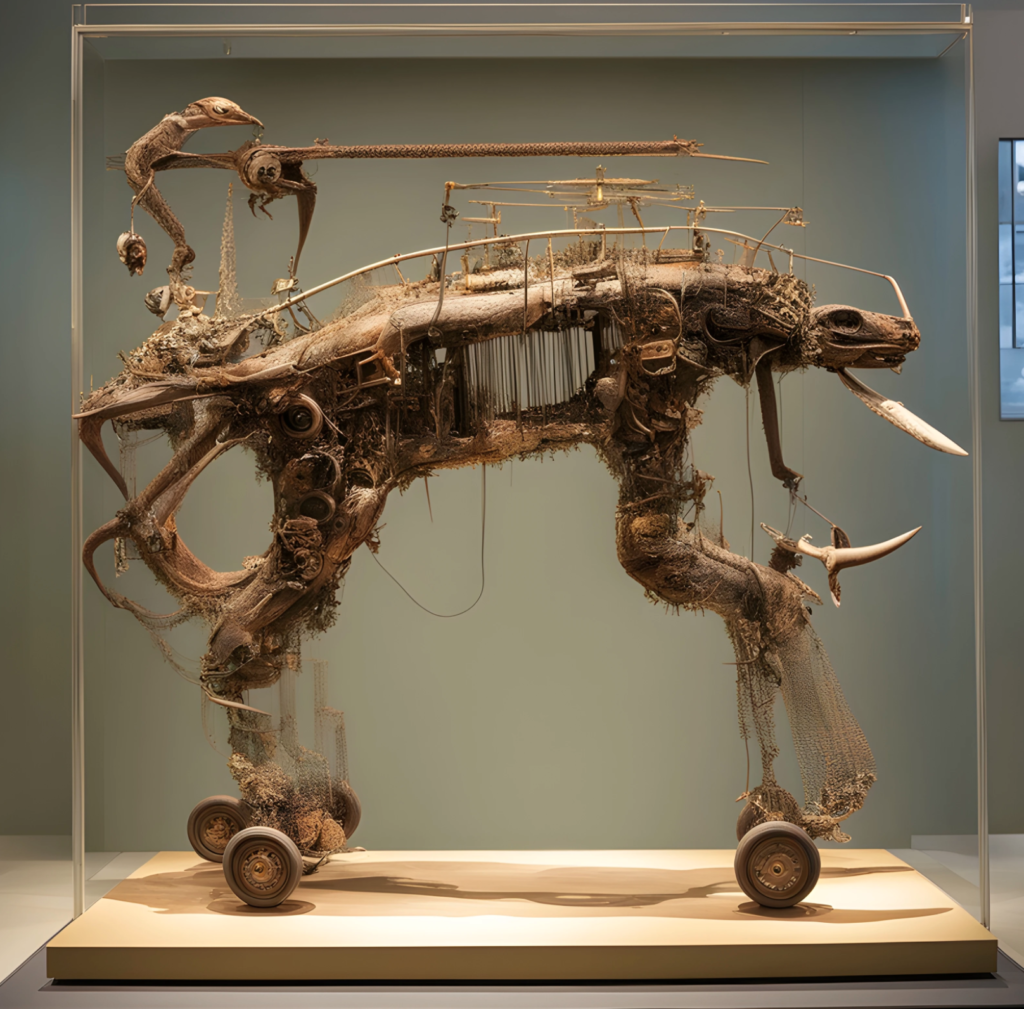
The Post Nature Museum, 2024, Project by: D.N.K. FILOART, AI Image Generator and Chat GPT
Post Nature Museum
The Post Nature Museum is a profound conceptual experiment in temporal perception and the interpretation of history. It subverts the conventional museum’s role, which typically preserves and showcases artifacts from a known past, by instead exhibiting relics from an imagined future that, paradoxically, is already past. This museum is not merely a collection of objects but a radical reimagining of our relationship with time, nature, and the artifacts we leave behind.
The Temporal Displacement
The Post Nature Museum engages in a temporal displacement that challenges our linear understanding of time. In this space, the future is not an impending unknown but a historical period that has already occurred, at least from the perspective of the museum’s narrative. This inversion of time creates a disorienting but intellectually stimulating experience. The museum curates artifacts as though the future has already unfolded, with us, the viewers, standing at a point even further ahead in time, looking back. This approach invites contemplation on the nature of progress, decay, and the inevitable transformation of both humanity and the natural world.
Artifacts as Cultural Reflections
The artifacts within the Post Nature Museum offer a speculative glimpse into a future where the boundaries between nature, technology, and humanity have blurred. These artifacts—remnants of humanoids, half-machine animals, or failed bio-experiments, and strange, possibly synthetic, growing trees—act as cultural reflections of our current anxieties and aspirations. These objects can be interpreted as symbols of the Anthropocene era, where human impact on the environment and the rapid advancement of technology have irrevocably altered the course of natural evolution.
Each artifact serves as a narrative device, telling stories of hybridization and adaptation. The humanoid remnants might suggest a future where humanity has merged with technology to the point of becoming unrecognizable. The half-machine animals could be seen as emblematic of our attempts to control and enhance nature, leading to unforeseen consequences. The strange trees, perhaps, represent the resilience of nature, albeit in a form that is as much artificial as it is organic.
The Museum as a Cultural Critique
By presenting these artifacts as relics from a “post-nature” time, the museum critiques contemporary environmental and technological trajectories. It forces us to confront the potential outcomes of our current actions and the ethical implications of our relentless drive toward progress. The museum is not just a repository of objects but a space for critical engagement. It uses the language of curation and display to question what future generations will consider “natural” and “authentic.”
The Post Nature Museum’s approach can be compared to that of dystopian literature or speculative fiction, where the future is imagined not as a utopia but as a cautionary tale. However, by situating this future in the past, the museum adds a layer of inevitability, suggesting that the consequences of our actions are not just possible but, in this narrative, have already occurred. This invites viewers to reflect on their role in shaping the future and the legacy they will leave behind.
The Role of Human-AI Collaboration in Documentation
A particularly intriguing aspect of the Post Nature Museum is its approach to documentation. All “photo documentation” of the museum’s exhibits is created through a collaboration between human artists and AI. This partnership between human creativity and artificial intelligence adds another layer of meaning to the museum’s narrative. It reflects the very future the museum is depicting—a world where human and machine have merged in new and unexpected ways. This collaboration can be seen as a meta-commentary on the evolving role of technology in art and cultural preservation. It raises questions about authenticity, authorship, and the future of creative expression.
The Role of the Viewer
Finally, the Post Nature Museum places the viewer in an unusual position—not as a passive observer of a distant past but as an active participant in the creation of history. As we navigate the museum, we are asked to imagine ourselves as both creators and inheritors of these future relics. This dual role challenges us to think critically about the impact of our choices and the kind of future we are building. The museum, in this sense, becomes a space of speculative archaeology, where the artifacts are not remnants of a lost civilization but warnings and lessons for the present.
In conclusion, the Post Nature Museum is a visionary project that redefines the museum as a space for temporal and cultural exploration. It is a bold statement on the fluidity of time, the malleability of nature, and the enduring question of what it means to be human in an era where the boundaries between the natural and the artificial are increasingly blurred. This museum does not just show us the past of the future; it forces us to reckon with the future of our present actions.
11. August 2024